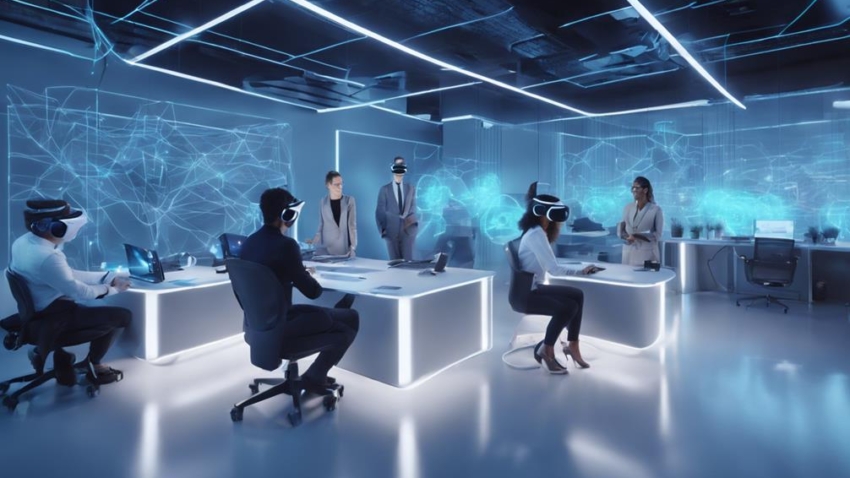
Virtual Reality: The Next Frontier in Corporate Training
Virtual reality is transforming corporate training by providing immersive, interactive, and personalized learning experiences that enhance knowledge retention, reduce costs, and improve operational efficiency. VR creates realistic and interactive environments, fostering emotional connections between learners and material, and allowing employees to practice critical skills in a risk-free environment. Gamification benefits and virtual mentorship further enhance the learning experience. With cost savings of up to 50%, VR training programs can be scaled to train multiple employees simultaneously. As we explore the vast potential of VR in corporate training, the possibilities for growth and innovation become even more promising.
Immersive Learning Experiences
As corporate training continues to evolve, a pivotal question arises: Can immersive learning experiences, facilitated by virtual reality, revolutionize the way employees acquire knowledge and skills? The answer lies in the unique benefits afforded by virtual reality (VR) technology. By creating highly realistic and interactive environments, VR enables employees to engage with complex information in a more intuitive and memorable way. This, in turn, fosters a deeper understanding and retention of material, ultimately leading to improved performance and decision-making.
One key advantage of VR-based training lies in its ability to create emotional connections between learners and the material. By simulating real-world scenarios, VR experiences can elicit powerful emotional responses, making the learning experience more impactful and memorable. Furthermore, gamification benefits can be seamlessly integrated into VR training programs, allowing learners to engage in friendly competition and collaboration, further enhancing knowledge retention and skill development.
The immersive nature of VR also enables employees to practice and rehearse critical skills in a risk-free environment, reducing the likelihood of costly mistakes in real-world applications. By leveraging the power of VR, organizations can create a new generation of highly skilled and confident employees, poised to drive business success in an increasingly competitive landscape. As the corporate training landscape continues to evolve, it is clear that immersive learning experiences facilitated by VR are poised to play a pivotal role in shaping the future of employee development.
Cost Savings and Efficiency
When it comes to corporate training, the incorporation of virtual reality can lead to significant cost savings and improved efficiency. By leveraging VR, companies can reduce training expenses, streamline their operations process, and optimize resource allocation. This trifecta of benefits enables organizations to allocate their resources more effectively, ultimately leading to improved productivity and competitiveness.
Reduced Training Expenses
In addition, by harnessing virtual reality in corporate training, organizations can greatly reduce their training expenses, achieving cost savings and efficiency through minimized logistical requirements and reduced instructor fees. This shift in approach enables businesses to optimize their budget allocation, reallocating resources previously spent on travel, accommodations, and venue rentals to more strategic initiatives. A thorough cost analysis reveals that VR-based training programs can reduce expenses by up to 50% compared to traditional methods. Additionally, the scalability of VR solutions allows for simultaneous training of multiple employees, further reducing the need for repeated instructor-led sessions. As a result, organizations can channel their resources towards more pressing priorities, such as talent development and innovation. By adopting VR-based training, companies can streamline their budget optimization efforts, achieving a more efficient and cost-effective approach to corporate training.
Streamlined Operations Process
Implementing virtual reality in corporate training enables organizations to streamline their operations process, yielding significant cost savings and efficiency gains through the elimination of logistical complexities and the automation of manual tasks. By leveraging VR technology, companies can simplify their training processes, reducing the time and resources required to train employees. This, in turn, enables process automation, allowing organizations to allocate resources more efficiently. With VR, training scenarios can be easily replicated and repeated, eliminating the need for physical infrastructure and reducing the risk of human error. Additionally, task prioritization becomes more effective, as VR training simulations can be tailored to focus on specific skills or competencies, ensuring that employees are equipped with the necessary knowledge and expertise to excel in their roles. By streamlining their operations process, organizations can redirect resources towards more strategic initiatives, driving growth and competitiveness in their respective markets.
Optimized Resource Allocation
In addition, through the strategic allocation of resources enabled by virtual reality-based training, organizations can reap significant cost savings and efficiency gains, freeing up budgetary allocations for more critical business imperatives. By optimizing resource allocation, companies can redirect funds towards high-priority initiatives, driving business growth and competitiveness.
Virtual reality-based training enables accurate budget forecasting, allowing organizations to make informed decisions about resource allocation. This precision enables companies to eliminate unnecessary expenditures, reduce waste, and allocate resources more effectively. In addition, workforce analytics can be leveraged to identify areas of inefficiency and optimize training programs, resulting in significant cost savings.
Enhanced Knowledge Retention Rates
Virtual reality (VR) technology has been shown to greatly enhance knowledge retention rates in corporate training settings. This is achieved through the creation of immersive learning experiences, interactive simulation training, and engaging visual content that captivate learners and facilitate better understanding and recall. By leveraging these innovative approaches, organizations can improve the effectiveness of their training programs and achieve lasting results.
Immersive Learning Experiences
In the domain of corporate training, immersive learning experiences have emerged as a game-changer, empowering employees to absorb and retain knowledge more effectively. By leveraging virtual reality technology, organizations can create personalized narratives that resonate with employees on a deeper level, fostering emotional connections that enhance knowledge retention.
This innovative approach to training enables employees to engage with complex information in a more immersive and interactive way, leading to improved comprehension and recall. For instance:
- Virtual field trips: Employees can explore virtual environments that simulate real-world scenarios, allowing them to apply theoretical knowledge in a practical setting.
- Interactive storytelling: Personalized narratives can be crafted to engage employees emotionally, making the learning experience more relatable and memorable.
- Virtual mentorship: Employees can receive guidance from virtual coaches or mentors, providing personalized feedback and support.
- Realistic simulations: Employees can participate in realistic simulations that mimic real-world challenges, allowing them to develop problem-solving skills in a safe and controlled environment.
Interactive Simulation Training
By leveraging interactive simulation training, organizations can greatly enhance knowledge retention rates, as employees are able to apply theoretical concepts to realistic, scenario-based challenges. This immersive approach enables learners to develop critical thinking and problem-solving skills, fostering a deeper understanding of complex concepts. To optimize the training experience, organizations can utilize training analytics to track learner progress, identify knowledge gaps, and refine their training strategies. Gamification strategies can also be incorporated to increase learner engagement, encouraging healthy competition and motivating employees to achieve mastery. By incorporating interactive simulation training into their corporate training programs, organizations can achieve significant improvements in knowledge retention, reducing the need for repeat training and enhancing overall performance. With the ability to track learner progress and adjust training strategies in real-time, organizations can take control of their training outcomes, driving business results and achieving a competitive edge.
Engaging Visual Content
Immersive visual content, rich in sensory details, has been demonstrated to greatly enhance knowledge retention rates, as the brain is wired to respond more effectively to visual stimuli, fostering a deeper and more lasting understanding of complex concepts. This is particularly relevant in corporate training, where engaging visual content can make all the difference in employee comprehension and retention.
To illustrate the power of engaging visual content, consider the following examples:
- 3D models of complex machinery, allowing employees to explore and interact with intricate systems in a highly immersive and intuitive way.
- Interactive animations, bringing dry concepts to life through dynamic, step-by-step illustrations that clarify complex processes.
- Virtual walkthroughs, guiding employees through realistic, scenario-based training exercises that simulate real-world challenges.
- 360-degree videos, placing employees in the midst of realistic, high-stakes scenarios that demand critical thinking and quick decision-making.
Simulating Real-World Scenarios
Virtual reality technology enables corporations to recreate realistic, high-stakes scenarios that would be impractical or costly to replicate in real life, allowing employees to practice critical skills in a controlled environment. This is particularly valuable for crisis management training, where the stakes are high and mistakes can have severe consequences. By simulating real-world scenarios, employees can develop essential skills such as risk assessment, crisis communication, and decision-making under pressure.
In a virtual environment, employees can practice responding to emergency situations, such as natural disasters or cyberattacks, and receive feedback on their performance. This allows them to refine their skills and develop muscle memory, so they can respond effectively in a real crisis. Additionally, VR simulations can be tailored to specific industries or roles, ensuring that employees receive training that is relevant to their job requirements.
The benefits of simulated scenario-based training extend beyond crisis management. By recreating everyday workplace scenarios, employees can practice soft skills such as communication, teamwork, and problem-solving. This can lead to improved collaboration, productivity, and overall job performance. As VR technology continues to evolve, corporations can create immersive, realistic, and engaging training experiences that prepare employees for even the most challenging real-world scenarios.
The Future of Onboarding
One of the most significant advantages of incorporating virtual reality into corporate training is its potential to revolutionize the onboarding process, transforming it from a tedious and time-consuming task into an engaging and interactive experience. By leveraging VR, organizations can create immersive and realistic simulations that simulate real-world scenarios, allowing new hires to familiarize themselves with company policies, procedures, and culture in a more engaging and memorable way.
Here are four ways VR can enhance the onboarding experience:
- Virtual facility tours: New hires can explore the office layout, meeting rooms, and common areas, reducing anxiety and uncertainty on their first day.
- Interactive role-playing: New employees can practice social interactions, such as introducing themselves to colleagues or responding to customer inquiries, in a low-stakes environment.
- Procedure simulations: New hires can practice procedural tasks, such as operating equipment or following safety protocols, in a realistic and risk-free environment.
- Virtual mentorship: New employees can receive personalized guidance and feedback from experienced mentors, fostering a sense of connection and support.
Soft Skills Training Revolution
Beyond onboarding, virtual reality is poised to transform soft skills training, enabling employees to develop critical skills like communication, collaboration, and leadership in a highly realistic and engaging manner. This revolution in soft skills training is particularly significant, as it addresses a critical gap in traditional training methods. Virtual reality-based soft skills training provides a safe and controlled environment for employees to practice and refine their skills, without the risk of real-world consequences.
In this immersive environment, employees can develop essential skills like social etiquette, emotional intelligence, and conflict resolution. They can practice maneuvering through complex social situations, such as networking events or difficult conversations, and receive instant feedback on their performance. This personalized and interactive approach enables employees to identify areas for improvement and track their progress over time.
Moreover, virtual reality-based soft skills training can be tailored to address specific business needs and objectives. For instance, a company can create customized scenarios that simulate real-world challenges, such as managing a team meeting or handling customer complaints. By providing a realistic and engaging platform for soft skills development, virtual reality is poised to revolutionize the way companies approach corporate training.
Industry Applications and Case Studies
Across various industries, from healthcare and finance to manufacturing and retail, virtual reality-based corporate training is being successfully implemented to address specific business challenges and improve employee performance.
One of the key benefits of VR-based training is its versatility, allowing companies to tailor their training programs to specific industry needs. For instance:
- Healthcare: Medical professionals can practice high-stakes surgeries and emergency response scenarios in a simulated environment, reducing the risk of errors and improving patient care.
- Manufacturing: Production line workers can train on complex machinery and assembly processes, increasing efficiency and reducing errors.
- Finance: Financial analysts can practice high-pressure trading scenarios, improving their decision-making skills and risk management.
- Retail: Sales associates can train on customer service scenarios, enhancing their communication skills and product knowledge.
Frequently Asked Questions
Can VR Training Be Integrated With Existing Learning Management Systems?
Imagine a seamless fusion of innovative training methods and existing infrastructure. Fortunately, VR training can be effortlessly integrated with existing Learning Management Systems (LMS). System compatibility is key, ensuring a cohesive experience for administrators and learners alike. Additionally, the fusion enables the tracking of valuable data analytics, providing insights to refine training programs and optimize results. With VR training integrated into your LMS, you're in control, with the power to monitor progress and make data-driven decisions.
How Do I Measure the ROI of VR Training for My Organization?
To measure the ROI of VR training, organizations must track key metrics. Start by identifying cost savings from reduced training time and increased productivity. Utilize data analytics to quantify training effectiveness, such as improved knowledge retention and skill mastery. Then, assess the business impact of VR training on key performance indicators, such as sales growth or error reduction. By monitoring these metrics, organizations can make data-driven decisions to optimize their VR training programs and maximize ROI.
Are VR Headsets a Hygiene Issue in Shared Training Environments?
Just as a well-oiled machine requires regular maintenance to avoid rust, a shared VR training environment demands attention to hygiene to prevent the spread of germs. VR headsets can indeed become a breeding ground for bacteria and viruses if not properly sanitized. To mitigate this risk, implement robust sanitization protocols and instill good user habits, such as regular cleaning and disinfection, to guarantee a healthy and safe training environment.
Can VR Training Be Used for Compliance Training and Certification?
Compliance training and certification are critical components of organizational risk management. VR training can effectively support these efforts by providing immersive, interactive experiences that simulate real-world scenarios. By incorporating VR into compliance training, organizations can guarantee employees are well-versed in regulatory updates and industry standards, reducing the risk of non-compliance. This approach enables organizations to maintain a culture of compliance, mitigating the threat of legal and reputational damage.
Do I Need Specialized IT Support to Implement VR Training?
Like a master key opening a treasure trove of possibilities, implementing VR training requires careful consideration of your IT infrastructure. While specialized IT support can be beneficial, it's not always necessary. What's essential is ensuring your technical expertise can handle the demands of VR. Assess your current infrastructure and determine if it can support the increased data and processing requirements. With a solid foundation, you'll be well on your way to accessing the full potential of VR training.











